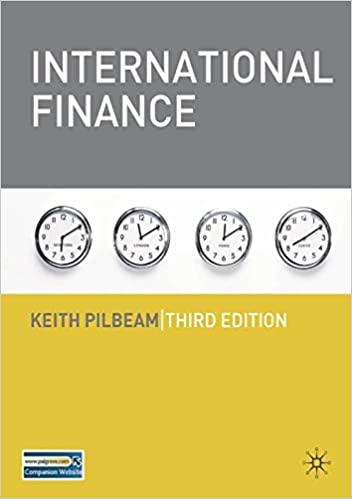Question
Question 9: Assume there is no secondary market for the bond in this question. Which of the following statements is incorrect? (This question is worth
Question 9: Assume there is no secondary market for the bond in this question. Which of the following statements is incorrect? (This question is worth 2 points.)
a) A bondholder would tend to exercise a bonds put provision with an increase in the market interest rate.
b) A bond issuer would tend to exercise a bonds call provision with a decrease in the market interest rate.
c) If a bondholder has redemption rights the holder would tend to exercise these rights with an increase in the market interest rate.
d) Typically, corporate bonds are issued by companies for the purpose of financing capital expenditure requirements and/or retiring long term higher coupon debt.
e) An abstract way of describing the exercise of a put is, Hey, give me my money back so I can lend it the higher market interest rate.
f) An abstract way of describing the exercise of a call is, Hey, Im giving you your money back so I can borrow at a lower market interest rate.
g) When the denominator of the bond version of the Universal Measure of Asset Value and Rate on a bond already issued in the primary market is lower than the current market interest rate then if given a chance, the borrower would likely want to repay the principal.
h) When the denominator of the bond version of the Universal Measure of Asset Value and Rate on a bond already issued in the primary market is higher than the current market interest rate then if given a chance, the lender would likely want to the borrower to repay the principal.
i) All of the above.
j) Only a, e, and h.
Question 10: Which of the following statements is correct? (This question is worth 2 points.)
a) A company may borrow capital from lenders or go to the shareholders for capital in terms of using retained earnings or raising new equity.
b) Most firms use a combination of capital types depending on the risk of a project and the return required by the providers of capital, i.e., the required rate of return.
c) Each type of capital has its own cost, i.e., the return required by the providers of that type of capital.
d) When a company borrows capital from lenders, the cost of that capital to the company is the interest rate.
e) When a company raises capital in the form of equity, the cost of that capital to the company are the dividends and capital appreciation expected by the shareholders.
f) When a company needs capital for a project, it figures out how much that capital will cost because if the project returns less than the cost of capital then the project is not financially feasible.
g) The cost of capital is the cost to the company to generate the numerator in the Universal Measure of Asset Value and Rate framework and the cost is captured in the frameworks denominator.
h) All of the above.
i) All except g.
j) None of the above.
Step by Step Solution
There are 3 Steps involved in it
Step: 1

Get Instant Access to Expert-Tailored Solutions
See step-by-step solutions with expert insights and AI powered tools for academic success
Step: 2

Step: 3

Ace Your Homework with AI
Get the answers you need in no time with our AI-driven, step-by-step assistance
Get Started


